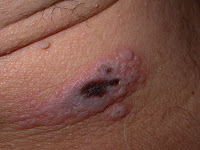Summer is here, and despite growing familiarity with the concept of sun protection over recent years, misconceptions abound concerning sun safety and how best to protect yourself from the damaging effects of the sun. The causative role of the sun is indisputable in skin cancer and premature aging of the skin. Even melanoma, the most rapidly increasing cancer in white populations, is strongly associated with intermittent sun exposure.
Here are six of the most commonly held myths surrounding sun protection.
Myth #1: All skin types require sunscreens.
The truth: Individuals with very fair skin (red hair, freckles, sunburn always) and fair skin (blue to hazel eyes, light skin, sunburn easily) benefit most from regular use of sunscreens. Natural pigment (i.e. melanin in the skin) is by far the most effective sunscreen. The darker a person’s skin, the greater the innate protection. Individuals with olive-colored (tan easily, rarely burn) or darker skin (never burn) have very little risk of developing the types of skin cancer that arise on sun-damaged skin. Sunscreens can help prevent further darkening after exposure to the sun, but skin cancer prevention and photo-aging is much less of an issue for individuals of color.
Myth #2: If you use appropriate sunscreens, sun exposure is safe.
The truth: Sunscreens mostly protect against burning rays (ultraviolet B, or UVB). Deep penetrating tanning rays (UVA) still get through to the dermis where they contribute to aging and skin cancer. The absence of sunburn with sunscreen gives a false sense of security and often translates to spending more time in direct sun. This is a potentially harmful practice, one that explains, in part, the increased incidence of melanoma that has been reported in sunscreen users.
The correct approach, then, for preventing skin cancer and photo-damage is to use sunscreens regularly as one part of a lifestyle of sun avoidance behavior (hats, long sleeves, long pants, shade). Daily sunscreens are especially important on the face, ears, neck and hands where coverage with clothing is difficult. If your goal is getting a tan or a dose of Vitamin D, it is safer to spend short amounts of time in the sun without sunscreen, then cover up or seek an umbrella.
Myth #3: If SPF-30 is good, SPF-60 must be twice as good.
False. Two points are crucial here. First, SPF-4 or SPF-8 sunscreens deliver inadequate protection, but once you get to SPF-15, you achieve more than ninety-two percent protection. Increasing to SPF-30 or SPF-60 merely takes it to ninety-four or ninety-five percent. The amount and frequency of application become the important issues, as long as you are using SPF-15 or higher.
Second, SPF grades only UVB protection (the burning rays). There is no equivalent grading system for UVA protection. One must rely on the ‘broad spectrum’ labeling to indicate UVA protection, and it is often inaccurate. The best UVA blockers are zinc oxide and titanium dioxide.
Myth #4: You don’t need sunscreens on a cloudy day.
The truth: Ultraviolet light intensity is not reduced on cloudy days. The rays get jumbled in the clouds, but the intensity hitting a person’s skin at ground level is the same as on a clear day. Cooler temperatures with clouds give a false sense of security which often means that people spend more time exposed without protection. Also, with ultraviolet intensity being greatest on June 21st every year in the Northern hemisphere, UV intensity in May can be the same as July, April can be the same as August, and March the same as September. Sunscreens should be used at least from March through September.
Myth #5: Sunscreens must be applied thirty minutes before going in the sun.
The truth: This is totally false. The chemicals and blocking agents in sunscreens are fully effective right out of the tube. In fact, the sun-blocking effects of sunscreens have been shown to be the strongest immediately after applying to the skin, and gradually fall off in strength over several hours.
Myth #6: Only specialty clothing provides good sun protection.
The truth: All types of clothing, when dry, protect from the skin from both UVB and UVA radiation. Of course, the tighter the weave, the better the protection. Specialty clothing manufacturers have designed excellent sun-protective clothing and have confirmed high SPF equivalency values, but the real benefits lie more in the comfort and lightness of their fabrics, not the sun protection per se.
The exception to this rule happens when fabrics get wet. Most standard clothes, t-shirts for instance, become worthless as sun barriers when they get wet. Specialty sun-protective garments maintain their SPF when wet, and highly protective swimwear is available for children and others spending hours in the water.














